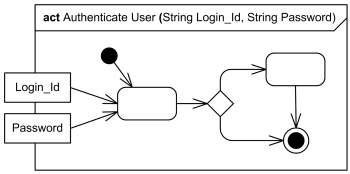Difference between revisions of "Unified Modeling Language"
(Created page with "{{TOCright}} UML or Unified Modeling (Eglish: Modelling) Language. == See also == * UML Category:Index Category:Modelling [[C...") |
m (→Activity Diagram) |
||
| (15 intermediate revisions by the same user not shown) | |||
| Line 1: | Line 1: | ||
{{TOCright}} | {{TOCright}} | ||
| − | UML or Unified Modeling (Eglish: Modelling) Language. | + | UML or Unified Modeling (Eglish: Modelling) Language <ref>[http://www.uml-diagrams.org UML-Diagrams], uml-diagrams.org is an excellent Website with lots of information on UML. The content of this Website is used for this Article.</ref> is a meta language which uses mainly diagrams <ref>[http://www.visual-paradigm.com/VPGallery/diagrams Visual Paradigm], UML-Diagrams.</ref> to describe a system. |
| + | |||
| + | == History == | ||
| + | The authors of UML are Grady Booch, James Rumbaugh en Ivar Jacobson (The Three Amigo's). They had all three their own specialism which has been standardized in UML. | ||
| + | * Booch had Booch 95, | ||
| + | * Rumbaugh had Object Modelling Technique (OMT) | ||
| + | * Jacobson had Object Oriented Software Engineering (OOSE). | ||
| + | https://upload.wikimedia.org/wikipedia/commons/d/dc/Objektorientieren_methoden_historie.png. | ||
| + | |||
| + | |||
| + | == Use Case Example == | ||
| + | {| class="wikitableharm" width="1100" | ||
| + | |- style="vertical-align:top;" | ||
| + | | rowspan="2" width="600" | http://www.uml-diagrams.org/use-case-diagrams/business-use-case-diagram-elements.png | ||
| + | | rowspan="1" width="250" | '''Components''' | ||
| + | * Use Case | ||
| + | * Actor | ||
| + | * Association | ||
| + | * System Boundary | ||
| + | There is a slight difference between a use case and a business use case. Same applies to Business Actor and Business boundary. Business can be recognized by the cross line. | ||
| + | | width="200" | '''Stereotypes''' | ||
| + | * Include, usage of another use case | ||
| + | * Extend, optional extension of another use case | ||
| + | |- style="vertical-align:top;" | ||
| + | | '''Template''' | ||
| + | * Number or name of the usecase | ||
| + | * Summary | ||
| + | * Actors | ||
| + | * Pre-condition | ||
| + | * Scenario | ||
| + | * Post-condition | ||
| + | * Alternatives | ||
| + | | width="200" | '''Miscellaneous''' | ||
| + | * Generalization | ||
| + | * Multiplicity | ||
| + | |} | ||
| + | |||
| + | == Activity Diagram == | ||
| + | {| class="wikitableharm" width="1100" | ||
| + | |- style="vertical-align:top;" | ||
| + | | rowspan="1" width="600" | http://www.uml-diagrams.org/activity-diagrams/activity-frame.png | ||
| + | | rowspan="1" width="500" | '''Components''' | ||
| + | * Start point | ||
| + | * Transition | ||
| + | * Action | ||
| + | * Merge | ||
| + | * Decision and Guards | ||
| + | * Split (fork) and Synchronization (join) | ||
| + | * Input / Ouput | ||
| + | * Event | ||
| + | * Swimlane | ||
| + | |} | ||
== See also == | == See also == | ||
| − | * [[wikipedia:Unified_Modeling_Language|UML]] | + | <span class="editsection">[[#content|top]]</span> |
| + | * [[wikipedia:Unified_Modeling_Language|UML]] on Wikipedia | ||
| + | * [http://www.visual-paradigm.com/VPGallery/diagrams/UseCase.html Visual Paradigm.com], Use Case | ||
| + | * [http://www.visual-paradigm.com/VPGallery/diagrams/Activity.html Visual Paradigm.com], Activity Diagram. | ||
| + | |||
| + | == Reference == | ||
| + | <span class="editsection">[[#content|top]]</span> | ||
| + | <references/> | ||
[[Category:Index]] | [[Category:Index]] | ||
[[Category:Modelling]] | [[Category:Modelling]] | ||
[[Category:Tools]] | [[Category:Tools]] | ||
Latest revision as of 13:38, 3 February 2015
UML or Unified Modeling (Eglish: Modelling) Language [1] is a meta language which uses mainly diagrams [2] to describe a system.
History
The authors of UML are Grady Booch, James Rumbaugh en Ivar Jacobson (The Three Amigo's). They had all three their own specialism which has been standardized in UML.
- Booch had Booch 95,
- Rumbaugh had Object Modelling Technique (OMT)
- Jacobson had Object Oriented Software Engineering (OOSE).
 .
.
Use Case Example

|
Components
There is a slight difference between a use case and a business use case. Same applies to Business Actor and Business boundary. Business can be recognized by the cross line. |
Stereotypes
|
Template
|
Miscellaneous
|
Activity Diagram

|
Components
|
See also
- UML on Wikipedia
- Visual Paradigm.com, Use Case
- Visual Paradigm.com, Activity Diagram.
Reference
- ↑ UML-Diagrams, uml-diagrams.org is an excellent Website with lots of information on UML. The content of this Website is used for this Article.
- ↑ Visual Paradigm, UML-Diagrams.